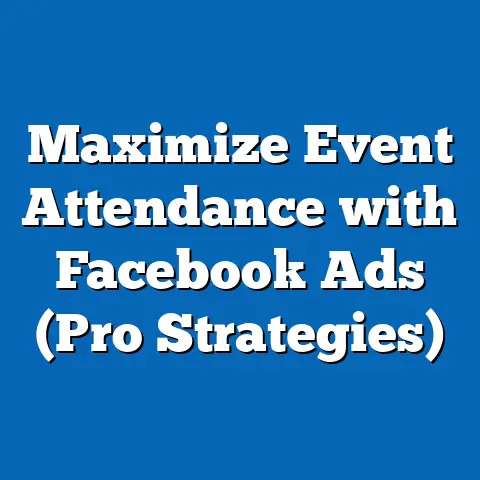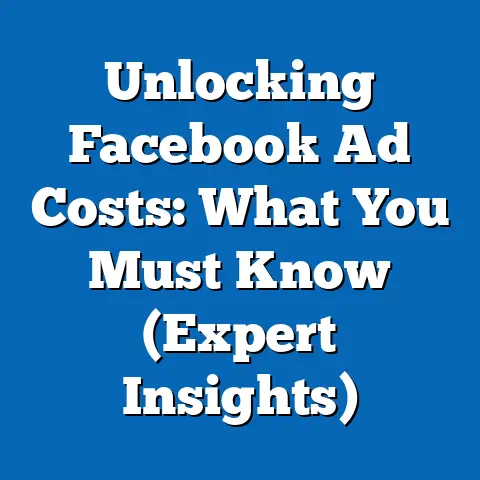Revive Ads: Overcoming Facebook Restrictions (Expert Guide)
Facebook advertising can feel like navigating a minefield. One wrong step, one misinterpreted rule, and BAM! Your ad gets rejected, your account gets restricted, and your carefully crafted campaign grinds to a halt. I’ve been there, countless times, and I know the frustration is real.
I remember launching a campaign for a local bakery, highlighting their delicious, freshly baked goods. We used mouth-watering images of croissants and cakes, and the targeting was spot on. Yet, the ad was rejected. Why? Apparently, the image of a cake with too much frosting violated their “health and fitness” policy, suggesting an unhealthy lifestyle. Seriously!
That experience, and many others like it, taught me a valuable lesson: understanding and navigating Facebook’s advertising policies is crucial for success. It’s not just about creating engaging content; it’s about creating compliant engaging content.
In this guide, I’ll share my expert insights on how to overcome Facebook’s advertising restrictions, revive your ads, and get your campaigns back on track. This isn’t just about avoiding rejection; it’s about turning these challenges into opportunities to refine your marketing skills and connect with your audience in a more meaningful way.
Understanding Facebook’s Advertising Policies
Facebook’s advertising policies are a complex and ever-evolving beast. They’re designed to protect users, ensure a positive experience, and maintain the integrity of the platform. While I understand the need for these policies, they can often feel arbitrary and confusing for advertisers.
The policies cover a wide range of topics, including:
- Prohibited Content: This includes anything illegal, discriminatory, or harmful. Think hate speech, violence, scams, and misleading information. It also extends to products and services that are prohibited, such as illegal drugs or weapons.
- Community Standards: These standards dictate what’s acceptable on the platform as a whole. Ads must align with these standards, meaning they can’t be offensive, shocking, or disrespectful.
- Ad Formats & Placement: Facebook has specific rules for different ad formats, like image sizes, video lengths, and text limits. They also regulate where ads can be placed, ensuring they don’t disrupt the user experience.
- Targeting: You can’t target users based on sensitive personal attributes like race, ethnicity, religion, or sexual orientation. While you can target interests related to these topics, the targeting itself can’t be discriminatory.
- Health & Fitness: As my bakery example showed, this policy can be surprisingly strict. Ads promoting weight loss products, supplements, or even certain types of food can face rejection if they’re deemed misleading or promote an unhealthy lifestyle.
Why do these policies exist?
Facebook wants to create a safe and positive environment for its users. They believe that by enforcing these policies, they can prevent the spread of misinformation, protect vulnerable populations, and maintain user trust.
Common Misconceptions:
- “My ad is harmless; it shouldn’t be rejected.” Intent doesn’t always matter. Even if your ad is well-intentioned, it can still violate the policies if it contains prohibited content or doesn’t meet the required standards.
- “My competitor is running a similar ad, so it’s okay.” Just because someone else is getting away with it doesn’t mean you will. Facebook’s enforcement isn’t always consistent, and you could still face rejection.
- “I can bypass the policies by using clever wording or images.” Facebook’s AI is getting smarter all the time. They can detect subtle violations, even if you try to be sneaky.
Takeaway: Familiarize yourself with Facebook’s advertising policies inside and out. It’s a dense document, but it’s essential reading for any serious advertiser. Regularly review the policies for updates, as they change frequently.
Reasons Ads Get Restricted or Rejected
Understanding the why behind ad rejections is just as important as knowing the what. Here’s a breakdown of the most common reasons why Facebook might restrict or reject your ads:
-
Misleading Content: This is a big one. If your ad contains false, exaggerated, or unsubstantiated claims, it’s likely to be rejected. This includes things like promising unrealistic results, using deceptive clickbait, or misrepresenting your product or service.
- Example: An ad for a weight loss supplement that claims you can “lose 20 pounds in a week without diet or exercise” would be a clear violation.
-
Inappropriate Targeting: As mentioned earlier, you can’t target users based on sensitive personal attributes. You also can’t use targeting options that are discriminatory or unethical.
- Example: Targeting an ad for housing specifically to people of a certain race or ethnicity would be illegal and a violation of Facebook’s policies.
-
Non-Compliance with Community Standards: Your ad can’t contain anything that violates Facebook’s community standards, such as hate speech, violence, or nudity.
- Example: An ad that promotes violence or incites hatred against a particular group would be immediately rejected.
-
Grammar and Spelling Errors: This might seem minor, but poor grammar and spelling can make your ad look unprofessional and untrustworthy. Facebook wants to maintain a high standard of quality, so they often reject ads with obvious errors.
- Example: An ad with multiple typos and grammatical mistakes will likely be rejected.
-
Low-Quality or Disruptive Content: Facebook wants to ensure that ads are relevant and engaging. Ads that are low-quality, repetitive, or disruptive to the user experience are likely to be rejected.
- Example: An ad that uses blurry images, overly aggressive sales tactics, or intrusive pop-ups would be considered low-quality and disruptive.
-
Promoting Prohibited Products or Services: Certain products and services are simply not allowed on Facebook, such as illegal drugs, weapons, tobacco products, and certain types of financial services.
- Example: An ad promoting the sale of firearms would be strictly prohibited.
-
Sensational Content: Facebook often restricts ads that use sensational or shocking content, especially if it’s designed to exploit or generate fear.
- Example: Ads showing graphic images of accidents or illnesses may get restricted due to their sensational nature.
-
Copyright Infringement: Using copyrighted images, music, or other materials without permission is a violation of Facebook’s policies and can lead to ad rejection.
- Example: Using a popular song in your video ad without obtaining the necessary licenses would be a copyright infringement.
Misleading Content: This is a big one. If your ad contains false, exaggerated, or unsubstantiated claims, it’s likely to be rejected. This includes things like promising unrealistic results, using deceptive clickbait, or misrepresenting your product or service.
- Example: An ad for a weight loss supplement that claims you can “lose 20 pounds in a week without diet or exercise” would be a clear violation.
Inappropriate Targeting: As mentioned earlier, you can’t target users based on sensitive personal attributes. You also can’t use targeting options that are discriminatory or unethical.
- Example: Targeting an ad for housing specifically to people of a certain race or ethnicity would be illegal and a violation of Facebook’s policies.
Non-Compliance with Community Standards: Your ad can’t contain anything that violates Facebook’s community standards, such as hate speech, violence, or nudity.
- Example: An ad that promotes violence or incites hatred against a particular group would be immediately rejected.
Grammar and Spelling Errors: This might seem minor, but poor grammar and spelling can make your ad look unprofessional and untrustworthy. Facebook wants to maintain a high standard of quality, so they often reject ads with obvious errors.
- Example: An ad with multiple typos and grammatical mistakes will likely be rejected.
Low-Quality or Disruptive Content: Facebook wants to ensure that ads are relevant and engaging. Ads that are low-quality, repetitive, or disruptive to the user experience are likely to be rejected.
- Example: An ad that uses blurry images, overly aggressive sales tactics, or intrusive pop-ups would be considered low-quality and disruptive.
Promoting Prohibited Products or Services: Certain products and services are simply not allowed on Facebook, such as illegal drugs, weapons, tobacco products, and certain types of financial services.
- Example: An ad promoting the sale of firearms would be strictly prohibited.
Sensational Content: Facebook often restricts ads that use sensational or shocking content, especially if it’s designed to exploit or generate fear.
- Example: Ads showing graphic images of accidents or illnesses may get restricted due to their sensational nature.
Copyright Infringement: Using copyrighted images, music, or other materials without permission is a violation of Facebook’s policies and can lead to ad rejection.
- Example: Using a popular song in your video ad without obtaining the necessary licenses would be a copyright infringement.
Expert Insight: I’ve found that the best way to avoid ad rejections is to think like Facebook. Put yourself in their shoes and ask yourself, “Would this ad be considered offensive, misleading, or harmful to users?” If the answer is yes, then it’s likely to be rejected.
Takeaway: Carefully review your ad copy, visuals, and targeting options to ensure they comply with Facebook’s policies. Pay attention to the details and don’t try to cut corners. Prevention is always better than cure.
Strategies to Overcome Restrictions
Okay, so you’ve had an ad rejected. Don’t panic! It happens to the best of us. The key is to learn from the experience and take steps to revive your ad and get it approved. Here are some strategies I’ve used successfully over the years:
-
A/B Testing for Compliance: A/B testing isn’t just for optimizing performance; it can also help you identify and eliminate potential policy violations. Create multiple versions of your ad with subtle variations in the copy, visuals, or targeting. Run these ads simultaneously and monitor their performance. If one version gets rejected while the others are approved, you’ll have a better idea of what might be causing the problem.
- Example: If you’re promoting a health supplement, try testing different wordings in your ad copy. Instead of saying “lose weight fast,” try “support healthy weight management.”
-
Content Creation Tips for Alignment:
- Focus on Benefits, Not Claims: Instead of making specific claims about your product or service, focus on the benefits it provides. For example, instead of saying “This product will cure your acne,” try “This product can help improve your skin’s appearance.”
- Use Positive Language: Avoid using negative or fear-based language in your ad copy. Focus on creating a positive and uplifting message.
- Be Transparent: Disclose any relevant information about your product or service, such as ingredients, potential side effects, or limitations.
- Use High-Quality Visuals: Make sure your images and videos are clear, professional, and relevant to your ad. Avoid using stock photos that look generic or unnatural.
- Consider the Context: Think about how your ad might be perceived by different audiences. Avoid using language or imagery that could be considered offensive or insensitive.
-
Utilizing Facebook’s Appeals Process: If you believe your ad was rejected unfairly, you have the right to appeal. The appeals process allows you to explain your case to Facebook and provide additional information to support your claim.
-
How to Appeal:
- Go to your Ads Manager.
- Find the rejected ad.
- Click on the “Appeal” button.
- Explain why you believe the ad was rejected in error. Be clear, concise, and professional.
- Provide any supporting documentation that might help your case.
-
Tips for a Successful Appeal:
- Be polite and respectful: Avoid getting angry or accusatory.
- Clearly explain your reasoning: Don’t just say “My ad doesn’t violate any policies.” Explain why you believe it’s compliant.
- Provide evidence: Back up your claims with data, research, or testimonials.
- Be patient: The appeals process can take time. Don’t expect an immediate response.
-
-
Staying Updated on Policy Changes: Facebook’s advertising policies are constantly evolving. It’s essential to stay informed about the latest changes to avoid unintentional violations.
- How to Stay Updated:
- Subscribe to Facebook’s Business Updates: This will ensure that you receive notifications about important policy changes.
- Join Industry Forums and Groups: Connect with other advertisers and share information about policy updates and best practices.
- Regularly Review Facebook’s Advertising Policies: Make it a habit to review the policies on a regular basis to stay up-to-date.
- How to Stay Updated:
-
Leveraging Alternative Platforms: While Facebook is a powerful advertising platform, it’s not the only game in town. Consider diversifying your ad spend across other platforms, such as Google Ads, LinkedIn Ads, or Twitter Ads. These platforms may have less restrictive policies, and they can also help you reach a different audience.
- Important Consideration: Diversifying doesn’t mean abandoning Facebook altogether. It’s about creating a balanced strategy that leverages the strengths of multiple platforms.
A/B Testing for Compliance: A/B testing isn’t just for optimizing performance; it can also help you identify and eliminate potential policy violations. Create multiple versions of your ad with subtle variations in the copy, visuals, or targeting. Run these ads simultaneously and monitor their performance. If one version gets rejected while the others are approved, you’ll have a better idea of what might be causing the problem.
- Example: If you’re promoting a health supplement, try testing different wordings in your ad copy. Instead of saying “lose weight fast,” try “support healthy weight management.”
Content Creation Tips for Alignment:
- Focus on Benefits, Not Claims: Instead of making specific claims about your product or service, focus on the benefits it provides. For example, instead of saying “This product will cure your acne,” try “This product can help improve your skin’s appearance.”
- Use Positive Language: Avoid using negative or fear-based language in your ad copy. Focus on creating a positive and uplifting message.
- Be Transparent: Disclose any relevant information about your product or service, such as ingredients, potential side effects, or limitations.
- Use High-Quality Visuals: Make sure your images and videos are clear, professional, and relevant to your ad. Avoid using stock photos that look generic or unnatural.
- Consider the Context: Think about how your ad might be perceived by different audiences. Avoid using language or imagery that could be considered offensive or insensitive.
Utilizing Facebook’s Appeals Process: If you believe your ad was rejected unfairly, you have the right to appeal. The appeals process allows you to explain your case to Facebook and provide additional information to support your claim.
-
How to Appeal:
- Go to your Ads Manager.
- Find the rejected ad.
- Click on the “Appeal” button.
- Explain why you believe the ad was rejected in error. Be clear, concise, and professional.
- Provide any supporting documentation that might help your case.
-
Tips for a Successful Appeal:
- Be polite and respectful: Avoid getting angry or accusatory.
- Clearly explain your reasoning: Don’t just say “My ad doesn’t violate any policies.” Explain why you believe it’s compliant.
- Provide evidence: Back up your claims with data, research, or testimonials.
- Be patient: The appeals process can take time. Don’t expect an immediate response.
How to Appeal:
- Go to your Ads Manager.
- Find the rejected ad.
- Click on the “Appeal” button.
- Explain why you believe the ad was rejected in error. Be clear, concise, and professional.
- Provide any supporting documentation that might help your case.
Tips for a Successful Appeal:
- Be polite and respectful: Avoid getting angry or accusatory.
- Clearly explain your reasoning: Don’t just say “My ad doesn’t violate any policies.” Explain why you believe it’s compliant.
- Provide evidence: Back up your claims with data, research, or testimonials.
- Be patient: The appeals process can take time. Don’t expect an immediate response.
Staying Updated on Policy Changes: Facebook’s advertising policies are constantly evolving. It’s essential to stay informed about the latest changes to avoid unintentional violations.
- How to Stay Updated:
- Subscribe to Facebook’s Business Updates: This will ensure that you receive notifications about important policy changes.
- Join Industry Forums and Groups: Connect with other advertisers and share information about policy updates and best practices.
- Regularly Review Facebook’s Advertising Policies: Make it a habit to review the policies on a regular basis to stay up-to-date.
- Subscribe to Facebook’s Business Updates: This will ensure that you receive notifications about important policy changes.
- Join Industry Forums and Groups: Connect with other advertisers and share information about policy updates and best practices.
- Regularly Review Facebook’s Advertising Policies: Make it a habit to review the policies on a regular basis to stay up-to-date.
Leveraging Alternative Platforms: While Facebook is a powerful advertising platform, it’s not the only game in town. Consider diversifying your ad spend across other platforms, such as Google Ads, LinkedIn Ads, or Twitter Ads. These platforms may have less restrictive policies, and they can also help you reach a different audience.
- Important Consideration: Diversifying doesn’t mean abandoning Facebook altogether. It’s about creating a balanced strategy that leverages the strengths of multiple platforms.
My Experience: One time, I was running an ad for a financial services company that was rejected because it was deemed to be “misleading.” After reviewing the policies, I realized that the ad was making overly optimistic claims about investment returns. I revised the ad to focus on the company’s expertise and track record, rather than promising specific results. I also provided a disclaimer that investment returns are not guaranteed. The revised ad was approved, and it performed even better than the original.
Takeaway: Don’t give up after your ad is rejected. Use these strategies to revive your ad and get your campaign back on track. Remember to be patient, persistent, and always stay informed.
Case Studies of Successful Revived Ads
Let’s look at some real-world examples of businesses that successfully revived their Facebook ads after facing restrictions:
-
Case Study 1: The Ethical Clothing Brand
- Challenge: A clothing brand promoting sustainable and ethically sourced apparel had their ads rejected due to “misleading business practices.” Facebook flagged the ads, suspecting false claims about the ethical sourcing of materials.
- Solution: The brand proactively provided detailed documentation to Facebook, including certifications from ethical sourcing organizations and supply chain audits. They also revised their ad copy to be more specific about their sourcing practices, avoiding vague terms like “eco-friendly” and instead using precise details like “made from 100% organic cotton certified by GOTS.”
- Results: The ads were approved, and the brand saw a 30% increase in click-through rates and a 20% increase in sales compared to their previous, less compliant ads.
- Key Takeaway: Transparency and documentation are key to overcoming suspicions of misleading business practices.
-
Case Study 2: The Local Gym
- Challenge: A local gym’s ads promoting weight loss programs were rejected due to violating the “health and fitness” policy. The ads featured before-and-after photos and made claims about guaranteed weight loss results.
- Solution: The gym removed the before-and-after photos and revised the ad copy to focus on the benefits of their fitness programs, such as improved strength, endurance, and overall health. They also added a disclaimer stating that results may vary.
- Results: The revised ads were approved, and the gym saw a steady increase in new memberships without making any unrealistic claims.
- Key Takeaway: Focus on promoting the benefits of your product or service rather than making specific claims about results.
-
Case Study 3: The Online Education Platform
- Challenge: An online education platform offering courses in various subjects had their ads rejected due to “low quality or disruptive content.” Facebook flagged the ads for using blurry images and generic ad copy.
- Solution: The platform invested in professional-quality images and videos that showcased their courses and instructors. They also revised their ad copy to be more specific about the skills and knowledge that students would gain from taking their courses.
- Results: The revised ads were approved, and the platform saw a significant increase in engagement and conversions.
- Key Takeaway: High-quality visuals and compelling ad copy are essential for creating ads that stand out and avoid being flagged as low quality.
Case Study 1: The Ethical Clothing Brand
- Challenge: A clothing brand promoting sustainable and ethically sourced apparel had their ads rejected due to “misleading business practices.” Facebook flagged the ads, suspecting false claims about the ethical sourcing of materials.
- Solution: The brand proactively provided detailed documentation to Facebook, including certifications from ethical sourcing organizations and supply chain audits. They also revised their ad copy to be more specific about their sourcing practices, avoiding vague terms like “eco-friendly” and instead using precise details like “made from 100% organic cotton certified by GOTS.”
- Results: The ads were approved, and the brand saw a 30% increase in click-through rates and a 20% increase in sales compared to their previous, less compliant ads.
- Key Takeaway: Transparency and documentation are key to overcoming suspicions of misleading business practices.
Case Study 2: The Local Gym
- Challenge: A local gym’s ads promoting weight loss programs were rejected due to violating the “health and fitness” policy. The ads featured before-and-after photos and made claims about guaranteed weight loss results.
- Solution: The gym removed the before-and-after photos and revised the ad copy to focus on the benefits of their fitness programs, such as improved strength, endurance, and overall health. They also added a disclaimer stating that results may vary.
- Results: The revised ads were approved, and the gym saw a steady increase in new memberships without making any unrealistic claims.
- Key Takeaway: Focus on promoting the benefits of your product or service rather than making specific claims about results.
Case Study 3: The Online Education Platform
- Challenge: An online education platform offering courses in various subjects had their ads rejected due to “low quality or disruptive content.” Facebook flagged the ads for using blurry images and generic ad copy.
- Solution: The platform invested in professional-quality images and videos that showcased their courses and instructors. They also revised their ad copy to be more specific about the skills and knowledge that students would gain from taking their courses.
- Results: The revised ads were approved, and the platform saw a significant increase in engagement and conversions.
- Key Takeaway: High-quality visuals and compelling ad copy are essential for creating ads that stand out and avoid being flagged as low quality.
These case studies demonstrate that it’s possible to revive your Facebook ads after facing restrictions by taking a proactive and strategic approach. By understanding the reasons for the rejection, revising your ads to comply with Facebook’s policies, and providing documentation to support your claims, you can get your campaigns back on track and achieve your advertising goals.
Embracing the Challenge
Overcoming Facebook’s advertising restrictions is not just a hurdle; it’s an opportunity. It’s an opportunity to refine your marketing skills, understand your audience better, and create more meaningful and impactful campaigns.
The ever-changing landscape of digital marketing requires adaptability and resilience. Don’t be discouraged by setbacks. Instead, embrace the challenge and view it as a chance to grow and innovate.
By staying informed, being proactive, and taking a strategic approach, you can navigate the complexities of Facebook’s advertising policies and create campaigns that not only comply with the rules but also resonate with your audience and drive results.
Call to Action
I’d love to hear about your experiences with Facebook ad restrictions. Share your stories, challenges, and successes in the comments below. What strategies have you found most effective? What are your biggest frustrations?
And if you’re looking for more expert insights and strategies on navigating the ever-evolving landscape of digital marketing, subscribe to my newsletter for regular updates and exclusive content. Let’s learn and grow together!





